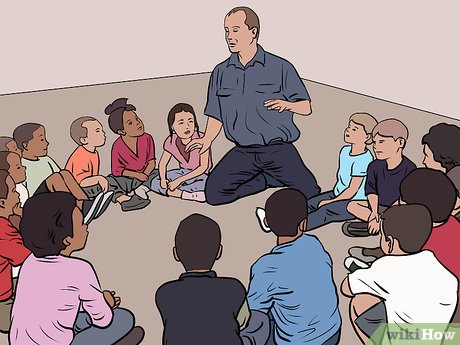How to Tell Scary Stories
Before horror movies laced with special effects kept people up at night, people got scared the old-fashioned way: through story-telling. The ability to spook people with only your voice is an ancient and endangered art, but through...
Part 1 of 3:
Preparing for the Storytelling
-
 Do your homework. Go to the library or search online for the scariest stories you can find. Pick out 5-10 stories that have spooking potential.
Do your homework. Go to the library or search online for the scariest stories you can find. Pick out 5-10 stories that have spooking potential.- The more realistic and recent the story, the scarier it'll be when you tell it. That way, the listeners can relate.
- Urban legends make excellent scary stories. The danger with using an urban legend, however, is that some of your listeners may have heard variations of it, thus ruining the effect.
-
 Localize it. Change the details so that it seems as though the story took place nearby, and recently. Weave fact with fiction. If the story took place in a canning factory, but you know there's a pecan factory in your town, switch out that detail (if you can do so without changing the story too much). If you can tie the story to someone you know, even better. Since your local conditions are unique, some of the stories will lend themselves better to this step than others. If rain is a critical detail in the story, for example, don't use it if you're camping in the desert. You should be able to narrow it down to 2-3 stories at this point.
Localize it. Change the details so that it seems as though the story took place nearby, and recently. Weave fact with fiction. If the story took place in a canning factory, but you know there's a pecan factory in your town, switch out that detail (if you can do so without changing the story too much). If you can tie the story to someone you know, even better. Since your local conditions are unique, some of the stories will lend themselves better to this step than others. If rain is a critical detail in the story, for example, don't use it if you're camping in the desert. You should be able to narrow it down to 2-3 stories at this point. -
 Rehearse. Practice telling the stories you've chosen and pay attention to which one feels the most natural. Tell it the same way you'd tell the story about that time your cousin tried to swallow a whole hot dog (minus the humor). Don't over-dramatize. Don't use words you wouldn't normally use. You want it to sound as if you're telling the story reluctantly, like it makes you uncomfortable, but you'll tell it if they twist your arm...
Rehearse. Practice telling the stories you've chosen and pay attention to which one feels the most natural. Tell it the same way you'd tell the story about that time your cousin tried to swallow a whole hot dog (minus the humor). Don't over-dramatize. Don't use words you wouldn't normally use. You want it to sound as if you're telling the story reluctantly, like it makes you uncomfortable, but you'll tell it if they twist your arm...
Part 2 of 3:
Setting Up the Tale
-
 Plant seeds of terror. Way before you tell the story (like the day before, or that morning), find a way to casually mention a few details that are relevant to the story. If you drive by the pecan factory, for example, ask your friends if they've ever been there. If you come across anything mysterious or unusual while your future listeners are around, try to think of a way you can tie it into your story and improvise! Let's say you find a squirrel skeleton and your story is about a serial killer. Perhaps that serial killer had an appetite for squirrels...? If you want to be really proactive, set things up. Draw a strange symbol on a rock with red chalk, or cut claw marks into fabrics.
Plant seeds of terror. Way before you tell the story (like the day before, or that morning), find a way to casually mention a few details that are relevant to the story. If you drive by the pecan factory, for example, ask your friends if they've ever been there. If you come across anything mysterious or unusual while your future listeners are around, try to think of a way you can tie it into your story and improvise! Let's say you find a squirrel skeleton and your story is about a serial killer. Perhaps that serial killer had an appetite for squirrels...? If you want to be really proactive, set things up. Draw a strange symbol on a rock with red chalk, or cut claw marks into fabrics.- Tweak the setting in the story to match the one you're in. If you noticed a huge tree next to a river, for instance, you can have one of the victims in your story cling to (coincidentally) a large tree next to a river as she flees from a ghost. Ideally, some of your listeners will remember having seen this tree, and will shudder when you mention it in the story. If it's a foggy night, make it a foggy night in your story.
Part 3 of 3:
Telling the Scary Story
-
 Seat your audience. Make them sit around you, facing you.You must be able to look everyone on the face.
Seat your audience. Make them sit around you, facing you.You must be able to look everyone on the face. -
 Build rapport with your listeners. The more they know and trust you, the easier it'll be to scare 'em. If you're the type to pull practical jokes often, it'll be much harder to establish credibility!
Build rapport with your listeners. The more they know and trust you, the easier it'll be to scare 'em. If you're the type to pull practical jokes often, it'll be much harder to establish credibility! -
 Act nervous and scared. When the time draws near to tell the story, start pretending to be anxious. Be a little quieter than usual. Get the chills here and there, and rub your upper arms as if to warm yourself. Look suddenly behind you, or at the distance, as if you just saw something. Keep doing this kind of stuff subtly until someone notices. At first, brush it off as if it's nothing, but keep up the act. Eventually, you'll....
Act nervous and scared. When the time draws near to tell the story, start pretending to be anxious. Be a little quieter than usual. Get the chills here and there, and rub your upper arms as if to warm yourself. Look suddenly behind you, or at the distance, as if you just saw something. Keep doing this kind of stuff subtly until someone notices. At first, brush it off as if it's nothing, but keep up the act. Eventually, you'll....- Tell the story in a slow, quiet yet audible voice. Change your tone constantly.
-
 Break down and tell the story. After saying you "don't want to talk about it," act as though you're too spooked to keep this to yourself, and you can't hold it in anymore. Again, don't be overly dramatic. You want to come off as uncomfortable, worried, reluctant. Hopefully by now, your listeners are both curious and concerned. Ask for a blanket to wrap around yourself (because you keep getting the chills, because you're so, so terrified) and start telling your story.
Break down and tell the story. After saying you "don't want to talk about it," act as though you're too spooked to keep this to yourself, and you can't hold it in anymore. Again, don't be overly dramatic. You want to come off as uncomfortable, worried, reluctant. Hopefully by now, your listeners are both curious and concerned. Ask for a blanket to wrap around yourself (because you keep getting the chills, because you're so, so terrified) and start telling your story. -
 End it with a bang. This is, for some, the best part. The last sentence of your story - the punchline, if you will - should be yelled suddenly, with you lunging forward at your listeners and scaring the life out of them. Note, however, that this step will make it very clear that your story was told solely for horrifying effect, and challenge your future storytelling reputation. If you want your listeners to turn in their beds at night, end the story as quietly and uncomfortably as you started it. Throw in a little chill for maximum effect.
End it with a bang. This is, for some, the best part. The last sentence of your story - the punchline, if you will - should be yelled suddenly, with you lunging forward at your listeners and scaring the life out of them. Note, however, that this step will make it very clear that your story was told solely for horrifying effect, and challenge your future storytelling reputation. If you want your listeners to turn in their beds at night, end the story as quietly and uncomfortably as you started it. Throw in a little chill for maximum effect.- Look each member of the audience in the eye. Make sure your face doesn't reveal that you're going to scare them. Wait and build up your story and come upon the scary part loudly or yell when they're least suspecting.
4 ★ | 2 Vote
You should read it
- How to add multiple photos to Facebook and Messenger Story
- How to use Story Archive on Facebook
- How to Tell Better Stories
- How to block Story Telegram to avoid disturbing
- This Instagram Story can cause your smartphone to hang
- How to Be Able to Create a Story
- How to tell stories with Stories on Instagram
- Old donkey story and thoughtful life lesson
- Instagram allows sharing posts to Stories
- 9 meaningful stories about money, willpower and wealth: The more you meditate, the more you understand, the more certain you will succeed.
- Instagram introduced two new stories to watch release
- Why do Stories fade after so long? Find answers













 The stories are more scary than horror movies
The stories are more scary than horror movies Photos that look normal but contain scary stories
Photos that look normal but contain scary stories 10 visual tricks make your Instagram Stories stand out
10 visual tricks make your Instagram Stories stand out How to tell stories with Stories on Instagram
How to tell stories with Stories on Instagram Cold with the mysterious stories about the 'ghost of the living'
Cold with the mysterious stories about the 'ghost of the living'